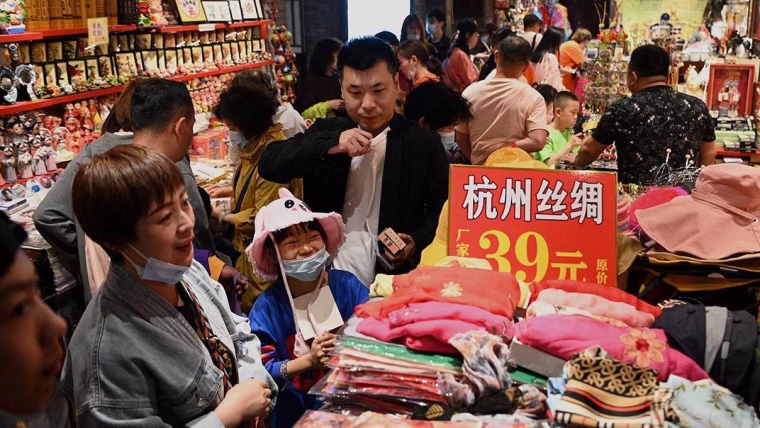
Recent price increases in the world’s two largest economies have unnerved global markets, which have become accustomed to the low inflation – and even deflation – that has prevailed for decades. But, at least in China, a little inflation would not be a bad thing.
In the United States, massive government spending during the COVID-19 crisis has raised fears of a financial reckoning, and recent price data are reinforcing these concerns. The consumer price index (CPI) surged by 4.2% year on year in April – the fastest growth since 2008. Moreover, the monthly increase accelerated to 0.8% in April, from 0.6% in March, although the rate fell back to 0.6% in May. The producer price index (PPI) has also risen, to 217.5 in April, up from 185.5 a year earlier.
These data have intensified pressure on the US Federal Reserve to tighten its ultra-loose monetary policy. And yet, in April, Fed Chair Jerome Powell stressed that the central bank is still a “long way” from withdrawing monetary support, even if that means allowing inflation to run above 2% temporarily. This should calm markets, though many economists remain convinced that the Fed is overestimating its ability to keep inflation under control in the longer term.
In China, the annual CPI rose 0.9% in April (year on year), compared with a 0.4% rise in March. More striking, the PPI soared by 6.8% year on year in April, reaching its highest level since October 2017. In May, the CPI and PPI both rose – and diverged – further, increasing by 1.3% and 9%, respectively.
And yet Chinese markets remain mostly calm. With Chinese economists far more worried about waning growth momentum in the second quarter than a surge in inflation, there is little pressure on China’s fiscal and monetary policymakers to pursue any kind of tightening.
There are good reasons for this. In May, while CPI rose 1.3%, its sequential rate fell 0.2%. Core CPI added only 0.9%.
The much larger rise in the PPI is being fueled by Chinese producers’ preparations for the post-pandemic surge in demand. Producers in the upstream portion of supply chains make the first move, rushing to stockpile raw materials and fossil fuels. That is why prices of commodities – such as copper, coal, iron ore, and aluminum – have shown double-digit increases since March.
But, with the pandemic recovery just beginning, demand for final products (especially consumer products) remains depressed. This explains the growing gap between the increases in the CPI and PPI. Producers of manufactured products in the middle and downstream portions of supply chains cannot pass the increased costs of inputs to consumers and investors. Other factors – such as the stockpiling of computer chips and the implementation of the government’s sustainability agenda – may have also contributed to the divergence between the producer and consumer price indices.
Many Chinese economists believe the surge in the PPI is merely transitional and may have already peaked. Even if it continues to rise, however, there would be no need to panic, as the recent increase did little more than make up for the losses incurred during the 2008 global financial crisis. Moreover, prior to the recent uptick, China had endured multiple years of producer-price deflation.
In any case, some economists argue that the PPI surge is unlikely to translate into significant CPI growth. This is supposed to be a comforting thought, indicating that China need not fear high inflation. But this scenario should actually be what concerns China, whose economy needs a little more inflation.
The lack of price pass-through – which has kept consumer inflation low – has squeezed the profits of downstream producers, even as upstream industries benefit from a sharp increase in profitability. This undermines consumption, investment, and, ultimately, economic growth. And for what? As a developing economy with a per capita income of just over $10,000, China can tolerate higher inflation better than developed economies can.
Given this, the Chinese government should be working to boost consumer inflation by embracing much more expansionary fiscal and monetary policies. Unlike the US, Europe, and Japan, China has not pursued a loose macroeconomic-policy approach during the pandemic. In May, the growth rate of M2 (a broad measure of money supply) was 8.3%, higher than in April, but 2.8 percentage points lower than in the same month a year earlier. And while national general public revenues increased by 25.5% in the first four months of 2021, national general public expenditures increased by just 3.8%.
This cautious approach has contributed to the weakening of China’s economic-growth momentum. Now, exports have again become a leading driver of growth – an unsustainable pattern that the country has been working hard to break. Fiscal and monetary expansion would go a long way toward reversing these trends.
Eventually – after enterprises recover their profitability and growth is back on track – inflation will stabilize at a positive, safe level.
Yu Yongding, a former president of the China Society of World Economics and director of the Institute of World Economics and Politics at the Chinese Academy of Social Sciences, served on the Monetary Policy Committee of the People’s Bank of China from 2004 to 2006. Copyright: Project Syndicate, 2021, and published here with permission.

We welcome your comments below. If you are not already registered, please register to comment.
Remember we welcome robust, respectful and insightful debate. We don't welcome abusive or defamatory comments and will de-register those repeatedly making such comments. Our current comment policy is here.